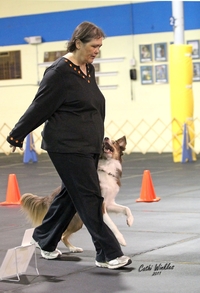The chin rest is an incredibly useful and versatile foundation skill. The more I use it, the more uses I find for it. I find it particularly helpful for cooperative care skills and stationary exercises. Once my dog has a solid and comfortable chin rest behavior then I can add more challenges in a variety of ways. At its heart the chin rest sounds so very simple; your dog rests his chin in the palm of your hand. From there you can move on to a 2 handed chin rest, a muzzle wrap, and chin rests to various surfaces. Duration can be extended and then other procedures and challenges can be added to the position. Join Deb for a week to work through a comprehensive step by step plan to develop strong and consistent chin rest behavior. Step 1: Single handed chin rest: getting the initial behavior Step 2A: Double chin rest: two hands Step 2 B: Double chin rest with muzzle wrap: thumbs over muzzle Step 3: Towel or pillow in lap: transferring the behavior Step 4: Ottoman/stool/chair/other prop Step 5: Reverse luring & zen bowl for duration and distraction Step 6: Adding handling Step 7: Variations (recalls, fronts, middle position, targeting, retrieves) Watch the trailer Deborah Jones, Ph.D. (she/her) is a psychologist who specializes in learning theory and social behavior. She taught a variety of psychology courses at Kent State University for the past 20 years. Deb has been training dogs for performance events for the past 25 years and was an early...(Click here for full bio and to view Deb's upcoming courses)Course Details
This is a previously run workshop. Your purchase will provide access to both the original presentation recording and the student feedback recording. There is no opportunity to submit video or ask questions.
 Instructor: Deborah Jones
Instructor: Deborah Jones